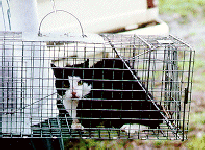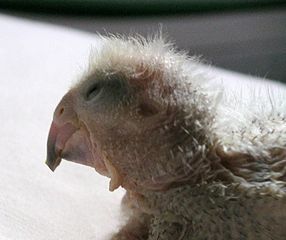Bird owners are usually concerned with the welfare of wild species, so today I’d like to focus on an underappreciated conservation concern, feral cat predation upon birds. Recent studies have shown that “trap-neuter-release” programs, collars with bells, and other popular control methods are failing to protect wildlife.
Feral Cats: Scope of the Problem
Although estimates of cat numbers vary widely, it is certain that feral and free-roaming house cats in the USA kill millions of native birds, reptiles and amphibians and billions of mammals yearly. Only 35% of the country’s 77,000,000+ pet cats are kept exclusively indoors, while 60-100 million feral individuals live exclusively outdoors. The effects of cats and other invasive species are second only to habitat loss as a cause of extinctions worldwide.
Rare and threatened species that have been killed by free-roaming cats include Florida Scrub Jays, Piping Plovers, Star-Nosed Moles, Pacific Pocket Mice and many others. On Oahu, Hawaii, cats and mongooses killed significant numbers of Laysan Albatross and Wedge-Tailed Shearwater chicks until the USA’s first predator-proof fence was installed around key nesting areas (please see article below).
Cat Prey Statistics
The recorded and estimated numbers of birds taken by cats vary by location and study method, but fieldwork on 4 continents and numerous islands has revealed consistent patterns.
In most habitats, birds make up 20-30% of feral cat diets, with the remainder being small mammals and, to a lesser degree, reptiles and amphibians. On some islands, however, birds comprise nearly 100% of the prey taken.
But even at 20% levels, the number of individual birds involved can be astounding. Studies in the USA have revealed that a single cat may kill 100-1,000 birds annually, and that the total number of birds taken yearly may exceed 200 million. In Great Britain, 964 cats killed 14,100 birds of 44 species in a 5 month period. Yet birds made up only 24% of the diet of the cats tracked in this study. Included among the balance were Dormice, Slow Worm Lizards and other species of conservation concern.

Cats have been identified as the primary cause of the extinctions of 33 bird species. One of these extinctions, that of New Zealand’s Stephen’s Island Wren, is widely attributed to the efforts of a single lighthouse keeper’s cat (in all fairness, it does seem that the infamous feline was helped by others…but not much!). Currently, cat eradication appears to be the best way to halt the decline of Australia’s rarest Psittacine, the Western Ground Parrot (please see article below).
Cats and Other Small Predators
It is also likely that feral cat populations negatively affect owls, foxes, weasels, bobcats and other animals that rely upon similarly-sized prey.
Where conditions are favorable, cats forgo most territorial behavior and can therefore increase dramatically in numbers (raccoons also do this, but other native predators do not). A University of Wisconsin study documented feral cat densities at 114 animals per square mile in one rural habitat…such an area would not support even one similarly-sized native predator.
Cats and Rodent Control
Although cats are often touted as providing valuable rodent control services indoors, the situation changes in outdoor environments. In several studies, populations of Deer Mouse and other native rodents crashed when feral cats became established, but House Mouse and Norway Rat numbers rose.
House Mice, ever adaptable, are able to thrive despite cat predation. I once saw an amazing series of photos depicting feral cats feeding side-by-side with Norway Rats in London. Cats, I learned, rarely attack Norway Rats once they reach 8 oz. or so in weight; the battle is just too risky. Having worked with wild-caught Norway Rats, I can understand completely!
Misconceptions
 A variety of non-lethal cat control methods, aimed at protecting wildlife while placating cat enthusiasts, are in use. One, known as “trap-neuter-release”, is endorsed by the ASPCA and has been adopted by several major municipalities. In theory, cats released back into their usual territory will discourage others from entering but, being neutered, will not reproduce.
A variety of non-lethal cat control methods, aimed at protecting wildlife while placating cat enthusiasts, are in use. One, known as “trap-neuter-release”, is endorsed by the ASPCA and has been adopted by several major municipalities. In theory, cats released back into their usual territory will discourage others from entering but, being neutered, will not reproduce.
However, studies have not been able to document the eradication of any feral colonies (i.e. following the natural deaths of all neutered cats) via such programs. In some cases, populations increased. As noted, feral cats may not attack newcomers if conditions are favorable, but rather may attract more (un-neutered) cats. People also tend to release unwanted cats in areas where others are observed. The American Bird Conservancy is lobbying against trap-release programs, and advises a legal prohibition on the feeding of stray cats.
Placing bells on the collars of free-ranging house cats has been shown to decrease hunting success in some instances. However, cats quickly adapt their stalking behaviors to compensate for the noise…in one UK study, cats with bells actually caught more birds than those without!
Risks to Free-Roaming House Cats
Coyotes are now well established near and even within Tuscon, Los Angeles, Chicago and many other major cities; at least 5 have made it into the heart of Manhattan! They present a significant danger to house pets that are allowed outdoors. In urban areas, studies show that cats have make up 13-42% of coyote diets. In suburban and rural areas, cats invariably disappear when coyotes become established (in a San Diego suburb, scrub-nesting birds returned soon after coyotes took up residence).
House cats are also at risk of contracting a wide variety of diseases and parasites from their feral counterparts. Some of these, such as toxoplasmosis (which infects an estimated 60-80% of all feral cats), present a significant health risk to people.
Further Reading
Cat Predation onWildlife, Great Britain
Cats and Western Ground Parrot Conservation
Western Ground Parrot image referenced from wikipedia and originally posted by Brent Barrett
 That Bird Blog – Bird Care and History for Pet Birds
That Bird Blog – Bird Care and History for Pet Birds




Great article Frank! We need to get cat owners to keep their cats indoors! Thanks for presenting the information on trap, neuter, release. The data really shows that it’s not effective. And by releasing the cats back outdoors, many birds and small animals are being doomed. There’s absolutely no reason why a cat needs to be outside. You presented a lot of the issues, which is terrific. That picture of the cat and the Major Mitchell’s cockatoo is horrific.
Thanks!!
Much appreciated, Amy, thank you. There’s a great many misconceptions, and cat-owners seem to be storng force in some communities. I just saw a news report on a controversy over a feral colony somewhere on Long Island…arguments/explanations given by those in favor of leaving the cats, and by local authorities, had no scientific basis at all. Frustrating, but business as usual…
Best, Frank
Great info, thanks for sharing. I had no idea that cats are such a threat. Good to know.
Hi Er5ic,
Thanks for the kind words, glad you enjoyed. Best, Frank